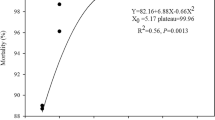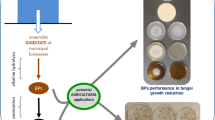Abstract
Defatted field pennycress (Thlaspi arvense L.) seedmeal was found to completely inhibit seedling germination/emergence when added to a sandy loam soil containing wheat (Triticum aestivum L.) and arugula [Eruca vesicaria (L.) Cav. subsp. sativa (Mill.) Thell.] seeds at levels of 1.0% w/w or higher. Covering the pots with Petri dishes containing the soil-seedmeal mixture decreased germination of both species at the lowest application rate (0.5% w/w), suggesting that the some of the phytotoxins were volatile. CH2Cl2, MeOH, and water extracts of the wetted seedmeal were bioassayed against wheat and sicklepod (Senna obtusifolia (L.) H. S. Irwin & Barneby) radicle elongation. Only the CH2Cl2 extract was strongly inhibitory to both species. Fractionation of the CH2Cl2 extract yielded two major phytotoxins, identified by gas chromatography–mass spectrometry and NMR as 2-propen-1-yl (allyl) isothiocyanate (AITC) and allyl thiocyanate (ATC), which constituted 80.9 and 18.8%, respectively, of the active fraction. When seeds of wheat, arugula and sicklepod were exposed to volatilized AITC and ATC, germination of all three species was completely inhibited by both compounds at concentrations of 5 ppm or less. In field studies, where seedmeal was applied at 0.50, 1.25, and 2.50 kg/m2 and tarped with black plastic mulch, all of the treatments significantly reduced dry weight of bioassay plants compared to the tarped control, with the highest seedmeal rate decreasing dry matter to less than 10% of the control 30 d after seedmeal application. Field pennycress seedmeal appears to offer excellent potential as a biofumigant for high-value horticultural crops for both conventional and organic growers.
Similar content being viewed by others
References
Al-Khatib, K., Libbey, C., and Boydston, R. 1997. Weed suppression with Brassica green manure crops in green pea. Weed Sci. 45:439–445.
Angus, J. F., Gardner, P. A., Kirkegaard, J. A., and Desmarchelier, J. M. 1995. Biofumigation: isothiocyanates released from Brassica roots inhibit growth of the take-all fungus. Plant and Soil 162:107–112.
Best, K. F. and McIntyre, G. I. 1975. The biology of Canadianweeds. 9. Thlaspi arvense L. Can. J. Plant Sci. 55:279–292.
Betz, J. M. and Fox, W. D. 1994. High-performance liquid chromatographic determination of glucosinolates in Brassica vegetables, pp. 181–196, Food Phytochemicals I: Fruits and Vegetables. ACS Symposium Series. American Chemical Society, Washington, DC.
Boydston, R. A. and Hang, A. 1995. Rapeseed (Brassica napus) green manure crop suppresses weeds in potato (Solanum tuberosum). Weed Tech. 9:669–675.
Boydston, R. A. and Vaughn, S. F. 2002. Alternative weed management systems control weeds in potato (Solanum tuberosum). Weed Tech. 16:23–28.
Brown, P. D. and Morra, M. J. 1995. Glucosinolate-containing plant tissues as bioherbicides. J. Agric. Food. Chem. 43:3070–3074.
Brown, P. D. and Morra, M. J. 1997. Control of soil-borne plant pests using glucosinolate-containing plants. Advan. Agron. 61:167–231.
Brown, P. D., Morra, M. J., McCaffrey, J. P., Auld, D. L., and Williams, L. III. 1991. Allelochemicals produced during glucosinolate degradation in soil. J. Chem. Ecol. 17:2021–2034.
Chew, F. S. 1988. Biological effects of glucosinolates, pp. 155–181, H. G. Cutler (ed.). Biologically Active Natural Products: Potential Use in Agriculture. American Chemical Society, Washington, DC.
Cole, R. A. 1976. Isothiocyanates, nitriles and thiocyanates as products of autolysis of glucosinolates in Cruciferae. Phytochemistry 15:759–762.
Daxenbichler, M. E., Spencer, G. F., Carlson, D. G., Rose, G. B., Brinker, A. M., and Powell, R. G. 1991. Glucosinolate composition of seeds from 297 species of wild plants. Phytochemistry 30:2623–2638.
Donkin, S. G., Eiteman, M. A., and Williams, P. L. 1995. Toxicity of glucosinolates and their enzymatic decomposition products to Caenorhabditis elegans. J. Nematol. 27:258–262.
Elberson, L. R., McCaffrey, J. P., and Tripepi, R. R. 1997. Use of rapeseed meal to control black vine weevil larvae infesting potted rhododendron. J. Environ. Hortic. 15:73–176.
Fenwick, G. R., Heaney, R. K., and Mullin, W. J. 1983. Glucosinolates and their breakdown products in food and food plants. Crit. Rev. Food. Sci. Nutr. 18:123–201.
Grossman, J. 1993. Brassica alternatives to herbicides and soil fumigants. IPM Pract. 15:1–10.
Holm, L., Doll, J., Holm, E., Pancho, J., and Herberger, J. 1997. World Weeds: Natural Histories and Distribution. John Wiley & Sons, New York.
Kirkegaard, J. A. and Sarwar, M. 1999. Glucosinolate profiles of Australian canola (Brassica napus annua L.) and Indian mustard (Brassica juncea L.) cultivars: implications for biofumigation. Aust. J. Agric. Res. 50:315–324.
Lewis, J. A. and Papavizas, G. C. 1971. Effect of sulfur-containing volatile compounds and vapors from cabbage decomposition on Aphanomyces euteiches. Phytopathology 61:208–214.
Lüthy, J. and Benn, M. H. 1977. Thiocyanate formation from glucosinolates: A study of the autolysis of allylglucosinolate in Thlaspi arvense L. seed flour extracts. Can. J. Biochem. 55:1028–1031.
Mayton, H. S., Olivier, C., Vaughn, S. F., and Loria, R. 1996. Correlation of fungicidal activity of Brassica species with allyl isothiocyanate production in macerated leaf tissue. Phytopathology 86:267–271.
Mclafferty, F. W. and Stauffer, D. 1989. Directory of Mass Spectral Data. John Wiley & Sons, New York.
Mitich, L. W. 1996. Field pennycress (Thlaspi arvense L.)—the stinkweed. Weed Tech. 10:675–678.
Mojtahedi, H., Santo, G. S., Hang, A., and Wilson, J. H. 1991. Suppression of root-knot nematode populations with selected rapeseed cultivars as green manure. J. Nematol. 23:170–174.
Mojtahedi, H., Santo, G. S., Wilson, J. H., and Hang, A. 1993. Managing Meloidogyne chitwoodi on potato with rapeseed as green manure. Plant Dis. 77:42–46.
Muelchen, A. M., Rand, R. E., and Parke, J. L. 1990. Evaluation of crucifer green manures for controlling Aphanomyces root rot of peas. Plant Dis. 74:651–654.
Olivier, C., Vaughn, S. F., Mizubuti, E. S. G., and Loria, R. 1998. Variation in allyl isothiocyanate production within Brassica species and correlation with fungicidal activity. J. Chem. Ecol. 25:2687–2701.
Papavizas, G. C. 1966. Suppression of Aphanomyces root rot of peas by cruciferous soil amendments. Phytopathology 56:1071–1075.
Papavizas, G. C. and Lewis, J. A. 1971. Effect of amendments and fungicides on Aphanomyces root rot of peas. Phytopathology 61:215–220.
Ramirez-Villapudua, J. and Munnecke, D. E. 1988. Effect of solar heating and soil amendments of cruciferous residues on Fusarium oxysporumf. sp. conglutinans and other organisms. Phytopathology 78:289–295.
Rask, L., Andreasson, E., Ekbom, B., Eriksson, S., Pontoppidan, B., and Meijer, J. 2000. Myrosinase: gene family evolution and herbivore defense in Brassicaceae. Plant. Mol. Biol. 42:93–113.
Rollins, R. C. 1993. The Cruciferae of Continental North America. Stanford University Press, Stanford, California.
Sarwar, M., Kirkegaard, J. A., Wong, P. T. W., and Desmarchelier, J. M. 1998. Biofumigation potential of brassicas. III. In vitro toxicity of isothiocyanates to soil-borne fungal pathogens. Plant and Soil 201:103–112.
Shofran, B. G., Purrington, S. T., Breidt, F., and Fleming, H. P. 1998. Antimicrobial properties of sinigrin and its hydrolysis products. J. Food Sci. 63:621–624.
Slater, G. P. 1992. Allyl thiocyanate-natural product or artifact in crucifer extracts? Chromatographia 34:461–467.
Springett, M. B. and Adams, J. B. 1989. Identification of 1-cyano-2,3-epithiopropane in volatiles of a model system from Brussels sprouts (Brassica oleracea L. var. bullata subvar. gemmifera DC). J. Sci. Food Agric. 46:211–219.
Tsao, R., Peterson, C. J., and Coats, J. R. 2002. Glucosinolate breakdown products as insect fumigants and their effect on carbon dioxide emission of insects. BMC Ecology 2:5.
Uda, Y., Kurata, T., and Arakawa, N. 1986. Effects of pH and ferrous ion on the degradation of glucosinolates by myrosinase. Agric. Biol. Chem. 50:2735–2740.
Vanetten, C. H. and Tookey, H. L. 1983. Glucosinolates, pp. 15–30, M. Rechcigl (ed.). Naturally Occurring Food Toxicants. CRC Press, Boca Raton, Florida.
Vaughn, S. F. 1999. Glucosinolates as natural pesticides, H. G. Cutler and S. J. Cutler (eds.). Biologically Active Natural Products: Agrochemicals. CRC Press, Boca Raton, Florida.
Vaughn, S. F. and Berhow, M. A. 1999. Allelochemicals isolated from tissues of the invasive weed garlic mustard (Alliaria petiolata). J. Chem. Ecol. 25:2495–2504.
Vaughn, S. F. and Boydston, R. A. 1997. Volatile allelochemicals released by crucifer green manures. J. Chem. Ecol. 23:2107–2116.
Vaughn, S. F., Boydston, R. A., and Mallory-Smith, C. A. 1996. Isolation and identification of (3-methoxyphenyl)acetonitrile as a phytotoxin from meadowfoam (Limnanthe alba) seedmeal. J. Chem. Ecol. 22:1939–1949.
Vaughn, S. F., Spencer, G. F., and Loria, R. 1993. Inhibition of Helminthosporium strains by natural isothiocyanates. Am. Pot. J. 70:852–853.
Walker, J. T. 1996. Crambe and rapeseed meal as soil amendments: nematicidal potential and phytotoxic effects. Crop. Prot. 15:433–437.
Warton, B., Matthiessen, J. N., and Shackleton, M. A. 2001. Glucosinolate content and isothiocyanate evolution—two measures of the biofumigation potential of plants. J. Agric. Food Chem. 49:5244–5250.
Williams-Woodward, J. L., Pfleger, F. L., Fritz, V. A., and Allmaras, R. R. 1997. Green manures of oat, rape and sweet corn for reducing common root rot in pea (Pisum sativum) caused by Aphanomyces euteiches. Plant Soil 188:43–48.
Author information
Authors and Affiliations
Corresponding author
Additional information
Names are necessary to report factually on available data; however, the USDA neither guarantees nor warrants the standard of the product, and the use of the name by USDA implies no approval of the product to the exclusion of others that may also be suitable.
Rights and permissions
About this article
Cite this article
VAUGHN, S.F., ISBELL, T.A., WEISLEDER, D. et al. BIOFUMIGANT COMPOUNDS RELEASED BY FIELD PENNYCRESS (Thlaspi arvense) SEEDMEAL. J Chem Ecol 31, 167–177 (2005). https://doi.org/10.1007/s10886-005-0982-4
Issue Date:
DOI: https://doi.org/10.1007/s10886-005-0982-4




